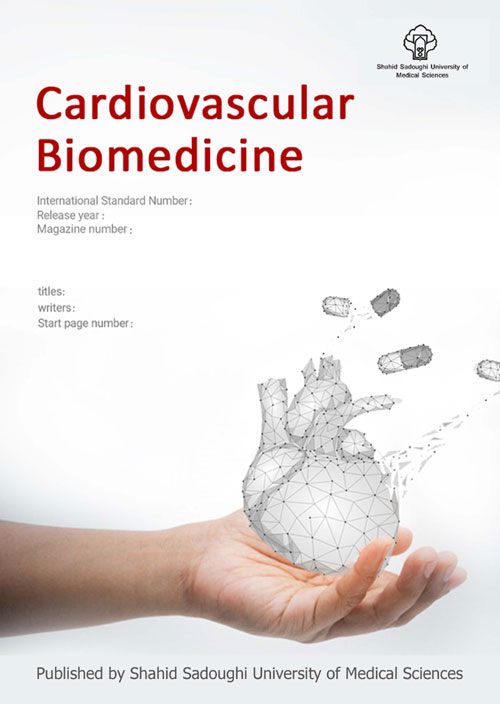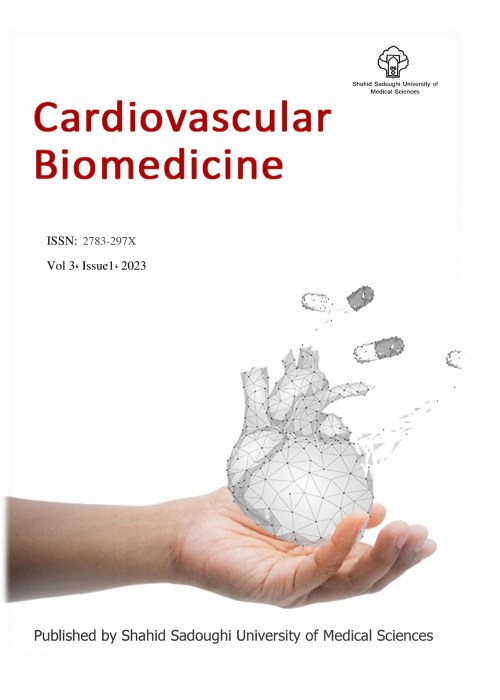فهرست مطالب

Cardiovascular Biomedicine Journal
Volume:1 Issue: 1, Summer and Autumn 2021
- تاریخ انتشار: 1400/06/02
- تعداد عناوین: 9
-
-
Pages 1-7Objectives
The occurrence of arrhythmias after myocardial infarction is associated with an increased risk of mortality. The purpose of this study was to investigate tachyarrhythmias after streptokinase therapy in myocardial infarction patients.
MethodsThis study was a case-control study. Among 262 patients with myocardial infarction who received streptokinase, 168 patients with ventricular tachyarrhythmia, ventricular fibrillation, or both (case group), and 94 patients without arrhythmia (control group) were selected. Their clinical information were collected by questionnaire. Data were analyzed using SPSS 20 software through chi-square test and Wilcoxon rank-sum.
ResultsThere was no relationship between demographic variables or electrocardiogram changes and the type of arrhythmia in 168 participants in the group 1 (p > 0.05). However, there was a significant relationship between age (p = 0.04), sex (p = 0.049), diabetes (p = 0.039), hypertension (p = 0.037), history of beta-blocker use (p = 0.028), history of aspirin use (p = 0.023), number of the leads involved (p = 0.023) and occurrence of arrhythmia among the participants in the group 2.
ConclusionsAccording to the findings of this study, patients with myocardial infarction who need to receive thrombolysis and who have any of the following conditions should be monitored by the health care staff to prevent development of ventricular tachyarrhythmias: old age, male gender, history of diabetes mellitus, hypertension or more lead involvement in their electrocardiogram.
Keywords: Cardiac arrhythmia, Electrocardiography, Myocardial infarction, Streptokinase therapy -
-
Pages 8-12ObjectivesAcute urinary retention (AUR) can occur as a complication after surgery or cardiac catheterization. The aim of this study was to evaluate the effect of wet gauze on relief of AUR in male patients after cardiac catheterization.MethodsIn this randomized controlled clinical trial, 36 male patients developing AUR after cardiac catheterization in Afshar Hospital, Yazd, Iran, were allocated to three groups; 13 patients in the group of immersed gauze in tepid water (40 centigrade), 12 patients in the dry gauze group, and 11 patients in the group without any intervention. The gauze was applied on symphysis pubis area. Elimination of AUR was compared between the three groups using chi-square analysis. One-way analysis of variance was used to find significant differences among the three groups regarding the time of relief from AUR.ResultsThe frequency of the relief of AUR was 61.5%, 25 %, and 9.1% in the groups of wet gauze, dry gauze and without intervention, respectively. There was a significant difference in relief of AUR among all groups (P = 0.022). The difference in relief of AUR between wet gauze group and other two groups was significant, too (P = 0.007). There was no significant difference in the time of relief of AUR among the three groups.ConclusionsAccording to the results of the study, it can be recommended to apply a gauze immersed in tepid water on the suprapubic area in male patients after cardiac catheterization to relieve AUR.Keywords: Acute urinary retention, Cardiac catheterization, Randomized controlled trial
-
Pages 13-19ObjectivesNowadays, vitamin D3 (VitD3) deficiency is among the most common dietary deficiencies around the world. Researchers have paid more attention to VitD3 because it is a vital element of the body and has a plausible relationship with various diseases such as diabetes mellitus type II. This study was conducted to examine the prevalence of vitamin D3 deficiency and its relationship with blood sugar levels in people with diabetes undergoing coronary artery bypass grafting (CABG).MethodsAn observational study was conducted in 2017 in Shahid Madani Hospital, Tabriz, Iran, for 8 months. Due to the use of census sampling, only 115 patients with diabetes and open-heart surgery were enrolled in the study. A questionnaire collected information on the participants' demographics, medical history, VitD3 levels and blood glucose levels. Data were analyzed using SPSS ver. 25. Independent t-test was used to compare quantitative data, and chi-square test was used to compare categorical variables.ResultsOne hundred and fifteen out of 348 patients who had CABG surgery were diabetic. Moreover, 24.7% of patients with diabetes had VitD3 deficiency. The results of the coefficient-correlation test indicated that there was a significant relationship between the mean blood glucose level and VitD3 level (p < 0.05).ConclusionsThe results of this study suggest that patients with diabetes can improve their blood glucose control after CABG surgery by taking sufficient VitD3. Therefore, it should be considered as a principle of the hospital operation to prescribe VitD3 prior to surgery for these patients.Keywords: Blood glucose level, Cholecalciferol, Coronary artery bypass, Diabetes mellitus
-
Pages 20-24ObjectivesDiabetes mellitus is one of the major risk factors for cardiovascular disease, and increases the risk of postoperative mortality. HbA1c is a measure of glycemic control. This study aimed to determine the effect of glycemic status on the complications of coronary artery bypass graf (CABG) surgery in diabetic patients.MethodsThis cross-sectional study was performed on 300 diabetic patients including 186 (62%) men and 114 (38%) women who underwent CABG from March 2010 to August 2011 and selected via census method. Preoperative blood glucose control status was determined using HbA1c levels, and the patients were evaluated for postoperative in-hospital complications.ResultsThe mean age of the patients was 62.3 ± 6.9 years. In-hospital mortality was 1.0% (3/300). New-onset atrial fibrillation was the most common complication (35%). HbA1c level above 7.5% was a predictor of in-hospital mortality after CABG (unadjusted odds ratio 1.9, 95٪ CI: 1.1-3.2, p = 0.006). After stratifying analysis with Chi-sqaure test we found that gender history of myocardial infarction had no significant relationship with HbA1c level in two groups with or without complication.ConclusionsLong-term uncontrolled blood glucose before CABG is associated with increased postoperative complications. Preoperative HbA1c measurement can be a predictor of high-risk patients.Keywords: Diabetes mellitus, HbA1c, CABG, Postoperative mortality, Glycemic control
-
Pages 25-30ObjectivesThe most common anticoagulant drug in the world is warfarin. Overdoses of warfarin may follow seasonal patterns, but the information is scarce. This study investigated possible seasonal variations in warfarin overdose among various age groups living in cold climates.MethodsThis retrospective study was carried out on 235 patients between 2014 and 2019 at Shahid Madani Hospital, Tabriz, Iran. The analysis was performed on the patients who had overdosed on warfarin and had INR (International Normalized Ratio) levels higher than four. After reviewing our database, we found seasonal patterns in admissions for overdoses caused by warfarin. The seasonality of access of patients older and younger than 65 years of age was compared between the two groups. The independent t-test was used to compare the quantitative data, and the Chi-square test was used to compare categorical variables using SPSS V. 20.0 software.ResultsSeasonal patterns were observed in warfarin overdoses. Warfarin overdoses were more common among the patients under 65 years old during winter (P-value = 0.03), whereas almost identical findings were found among the patients 65 and older, although numerically more cases were seen during the summer season (P-value = 0.8).ConclusionsThe results of the current study showed that warfarin overdoses in the patients younger than 65 years showed a seasonal pattern peaking in the winter months. However, these findings did not have any relation with older patients. To confirm the results of the present study, larger prospective multicenter studies in a variety of climate settings are needed.Keywords: Comparison, Warfarin, Drug overdose, Season Age
-
Pages 31-39ObjectivesAortic dissections of type A are clinical emergencies that can prove fatal if not managed promptly in specialized care facilities. Poor clinical management is the cause of approximately 1% of deaths in patients; however, with advances in clinical practice, diagnostic imaging and clinician awareness, the mortality rate has been dramatically reduced to below 30% in most international centers. We examined the potential factors involved in mortality after surgery for type A dissections.MethodsIn this descriptive-analytical study, patients who underwent acute aortic dissection surgery in the Shahid Madani Hospital of Tabriz, Iran, between March 2009 and March 2020 were evaluated. Exclusion criteria included those who died before the surgery, patients with descending aortic dissection, and high-risk patients for surgery who were candidates for medical treatment. Among 185 operated patients, 137 were included. Males comprised 62.8% of the patients. Their mean (±SD) age was 53.9 (±15.3) years.ResultsAge (p-value < 0.0001), the presence of hypertension (p-value = 0.015), the amount of packed red blood cell transfusion (p-value = 0.024) and the amount of platelet transfusion (p-value = 0.018) were associated with increased mortality. Duration of intubation, use of fresh frozen plasma, postoperative drainage, duration of intensive care unit recovery, high serum creatinine, duration of aortic clamping, brain protection method, and smoking were not associated with increased mortality.ConclusionsThese findings suggest that participants' mortality is dependent on several variables. Mortality of the patients with type A dissection can be reduced by interventions and reducing those factors.Keywords: Aortic dissection, mortality, Risk factors
-
Pages 40-45Objectives
The burden of valvular heart disease (VHD) is high and increasing all around the world dueto aging of the population. The etiologic factors of VHD are different among countries. There is littledata about etiologic factors of VHD in Iran. The aim of present study was to determine the associatedfactors related to the 5-year survival and mortality rate of patients undergoing bileaflet mechanical valvereplacement.
MethodsIn this retrospective cohort study, demographic, electrocardiographic and echocardiographicdata of patients who had underwent aortic, mitral and tricuspid valve replacement with bileaflet valvesin the Afshar Hospital in Yazd, Iran, between March 2008 to February 2015 were obtained from theirrecords. Supplementary information like hemorrhagic or thromboembolic events, rehospitalization anddeath during follow-up were gathered through contact with patients. For analysis of the data, SPSS ver.19 was used.
ResultsFour hundred and thirty eight patients entered the study. Male gender was slightly predominant(%53). Mean age of the patients was 51.6 ± 17.4 years. The rate of in-hospital mortality was 9.8% whilethe 5-year survival rate was 82.42%. The rate of major thromboembolic events was 0.97%/year andthat of major hemorrhagic events was 0.5%/year. Patients with older age, lower cardiac ejection fraction(less than 30%) and with atrial fibrillation had a higher rate of mortality (P = 0.001). In-hospitalmortalities were 3%, 9%, 12% and 15% for AVR, AVR+MVR, MVR and CABG+valvular surgery,respectively.
ConclusionsHigher rate of mitral valve surgery in this study may be due to possible predominance ofrheumatic valvular pathology similar to other developing countries. Rate of 5-year survival,thromboembolic and hemorrhagic rates were acceptable and comparable to global reports.
Keywords: Complications, Hemorrhagic, Survival, Thromboembolism, Valvular heart disease


